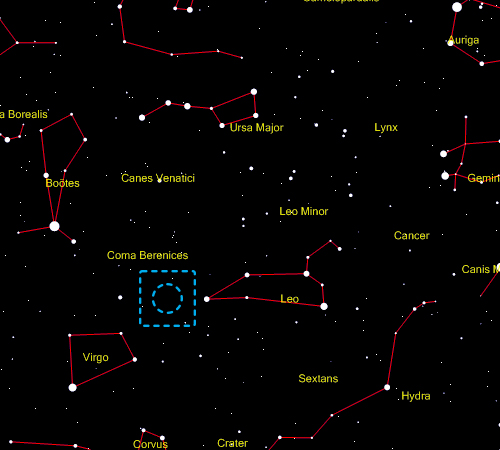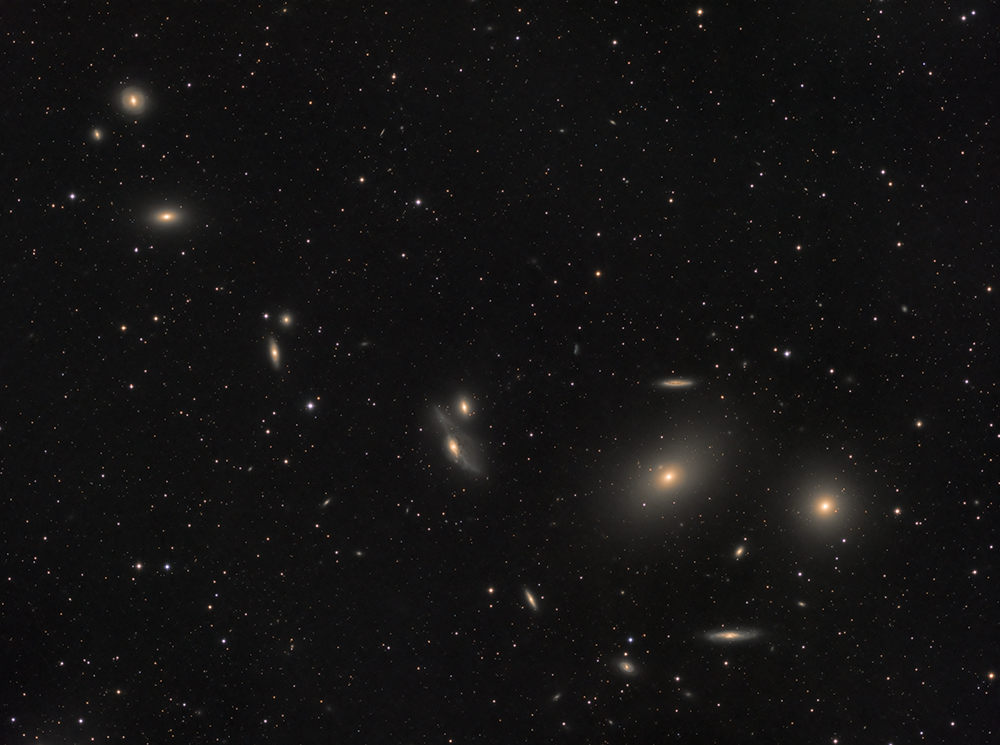Here we have a spectacular sweep of galaxies in the heart of the Virgo Cluster some 50 million light years away on the border of the constellations of Virgo and Coma Berenices, known as Markarian's Chain. It contains eight main galaxies, from left to right they are; NGC 4477, NGC 4473, NGC 4461, NGC 4458, NGC 4438, NGC 4435, M86 and M84. If you roll your mouse over the image, you will see a fully annotated version that clearly circles and labels all the NGC and Messier objects. In total there are some 220 catalogued galaxies in this field of view.
Charles Messier first discovered the two brightest galaxies in the chain on the night of the 18th March 1781 and catalogued them as M84 and M86. That night was a frustrating one for Messier, who found seven other non-comet objects around this area of sky to add to his list; M85, M87, M88, M89, M90, M91 and M92! The remainder of the chain's galaxies were catalogued in John Louis Emil Dreyer's New General Catalogue, published in 1888. However the chain gets its name from the Armenian astrophysicist, Benjamin Markarian, who, in the early 1960's, was the first to discover that the galaxies share a common motion through space. At least seven Markarian galaxies appear to move coherently, while others are merely superimposed in the same line of sight.
Considering each of the main galaxies in turn, we start with NGC 4477. It is a Seyfert-2 barred lenticular galaxy about 54 million light years away in the constellation of Coma Berenices, with a visual magnitude of 10.4. It was discovered on 8th April 1784 by William Herschel. On that same night, Herschel discovered the next galaxy in the chain, NGC 4473, an elliptical galaxy around 54 million light years away also in Coma Berenices, with an apparent magnitude of 10.2.
Next we come to the pair of galaxies NGC 4461 and NGC 4458. NGC 4461, a lenticular galaxy of apparent magnitude 11.2, about 50 million light years away in Virgo, is the lower of the two and is also cataloged as NGC 4443. It was first discovered in April 1784 by William Herschel, but was independently found by Lord Rosse in April 1849, which led to its double listing. Its companion, NGC 4458, is an elliptical galaxy about 55 million light years away in Virgo, also discovered by Herschel in April 1784. It has an apparent magnitude of 12.1.
The central pair of galaxies in this image are NGC 4438 and NGC 4435, known as 'The Eyes' as they resemble a pair of eyes when viewed through a small telescope. They are an interacting pair of galaxies about 52 million light years away in the constellation of Virgo. It is thought that the galaxies' interaction brought them within 16,000 light years of each other in the past and the gravitational forces of the encounter ripped away material, dust and gas from each of the galaxies. This disfigurement is clearly visible in the lower of the two, NGC 4438. Measurments taken today correspond to a separation between the two galaxies of about 100,000 light years.
Finally we come to the two Messier objects, M86 and M84. M86 is an elliptical or lenticular galaxy about 52 million light years away in the constellation of Virgo. It covers an apparent area of sky about 8.9 x 5.8 arc minutes, which corresponds to a diameter of about 130,000 light years. M86 displays the greatest blue shift of all Messier objects, approaching the Milky Way at around 240 km/s. It contains around 3,800 globular clusters. Furthermore, it is suffering ram-pressure stripping, losing its interstellar medium as it moves through Virgo's intracluster medium at such high speed. This leaves behind an expansive trail of x-ray emitting hot gas.
M84 is an elliptical or lenticular galaxy located in the inner region of the Virgo Cluster, about 60 million light years from Earth in the constellation of Virgo. It covers about 6.5 x 5.6 arcminutes of sky, corresponding to a diameter of about 110,000 light years. M84 contains few young stars and clusters, indicating that star forming activity in the galaxy is at a very low rate. The galaxy is receding from us at about 1,000 km/s. Investigations in radio wavelengths and images taken by the Hubble Space Telescope in 1997 have revealed two jets of matter emanating from the core of M84 and a disk of rapidly rotating stars and gas, which indicates that the galaxy contains a supermassive black hole at its centre. The black hole has an estimated mass of 1.5 billion solar masses.
Markarian's Chain is beautiful curved alignment of distant galaxies that is well worth trying to spot through a telescope on a clear and dark spring night. |


